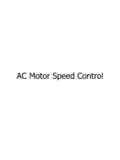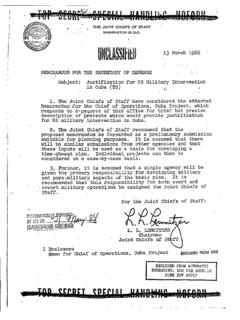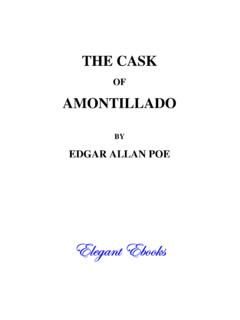Transcription of VIPer22A-E VIPer22ADIP-E, VIPer22AS-E - STMicroelectronics
1 November 2010 Doc ID 12050 Rev 21/2121 VIPer22A-EVIPer22 ADIP-E, VIPer22AS-ELow power OFF-line SMPS primary switcherFeatures Fixed 60 kHz switching frequency 9 V to 38 V wide range VDD voltage Current mode control Auxiliary undervoltage lockout with hysteresis High voltage start-up current source Overtemperature, overcurrent and overvoltage protection with auto-restart DescriptionThe VIPer22A-E combines a dedicated current mode PWM controller with a high voltage power MOSFET on the same silicon applications cover off line power supplies for battery charger adapters, standby power supplies for TV or monitors, auxiliary supplies for motor control, etc. The internal control circuit offers the following benefits:Large input voltage range on the VDD pin accommodates changes in auxiliary supply voltage. This feature is well adapted to battery charger adapter burst mode in low load condition. Overvoltage protection in HICCUP mode.
2 Figure diagramTable power capabilityMains type SO-8 DIP-8 European (195 - 265 Vac) 12 W 20 W US / wide range (85 - 265 Vac) 7 W 12 W DIP-8SO-8 VDRAINSOURCEVDDPWMLATCH60kHzOSCILLATORBL ANKING+_8 + k 42V_+R2 FFSRQ230 , VIPer22 ADIP-E, VIPer22AS-E 2/21 Doc ID 12050 Rev 2 Contents1 Electrical data .. ratings .. data .. 32 Electrical characteristics .. 43 Pin connections and function .. 64 Operations .. U-I output characteristics .. range of VDD voltage .. pin principle of operation .. sequence .. threshold .. 125 Operation pictures .. 136 Package mechanical data .. 167 Order codes .. 198 Revision history .. 20 VIPer22A-E , VIPer22 ADIP-E, VIPer22AS-E Electrical dataDoc ID 12050 Rev 23/211 Electrical Maximum ratingsStressing the device above the rating listed in the absolute maximum ratings table may cause permanent damage to the device.
3 These are stress ratings only and operation of the device at these or any other conditions above those indicated in the operating sections of this specification is not implied. Exposure to absolute maximum rating conditions for extended periods may affect device reliability. Thermal dataTable maximum rating Symbol Parameter Value Unit VDS(sw) Switching drain source voltage (TJ = 25 .. 125 C) (1)1. This parameter applies when the start-up current source is OFF. This is the case when the VDD voltage has reached VDDon and remains above .. 730 V VDS(st) Start-up drain source voltage (TJ = 25 .. 125 C) (2)2. This parameter applies when the start up current source is on. This is the case when the VDD voltage has not yet reached VDDon or has fallen below.
4 400 V ID Continuous drain current Internally limited A VDD Supply voltage 0 .. 50 V IFB Feedback current 3 mA VESD Electrostatic discharge: Machine model (R = 0 ; C = 200 pF) Charged device model V kV TJ Junction operating temperature Internally limited C TC Case operating temperature -40 to 150 C TstgStorage temperature-55 to 150 C Table dataSymbolParameterSO-8 DIP-8 UnitRthJCThermal resistance junction - caseMax2515 C/WRthJAThermal resistance junction - ambient (1)1. When mounted on a standard single-sided FR4 board with 200 mm2 of Cu (at least 35 m thick) connected to all DRAIN C/WElectrical characteristicsVIPer22A-E, VIPer22 ADIP-E, VIPer22AS-E 4/21 Doc ID 12050 Rev 22 Electrical characteristicsTJ = 25 C, VDD = 18 V, unless otherwise specifiedTable sectionSymbol Parameter Test conditions MinTypMaxUnit BVDSS Drain-source voltage ID = 1 mA; VFB = 2 V 730 V IDSSOFF state drain current VDS = 500 V; VFB = 2 V; TJ = 125 C mA rDS(on) Static drain-source ON state resistance ID = A ID = A; TJ = 100 C 1517 31 tf Fall time ID = A; VIN = 300 V (1)(See Figure 9 on page 13) 1.
5 On clamped inductive load100 ns tr Rise time ID = A; VIN = 300 V (1)(See Figure 9 on page 13) 50 ns COSS Drain capacitance VDS = 25 V 40 pF Table sectionSymbol Parameter Test conditions MinTypMaxUnit IDDch Start-up charging current 100 V VDS 400 V; VDD = 0 V ..VDDon(See Figure 10 on page 13) -1 mA IDDoff Start-up charging current in thermal shutdown VDD = 5 V; VDS = 100 V TJ > TSD - THYST 0 mA IDD0 Operating supply current not switching IFB = 2 mA 3 5 mA IDD1 Operating supply current switching IFB = mA; ID = 50 mA (1)1. These test conditions obtained with a resistive load are leading to the maximum conduction time of the mA DRST Restart duty-cycle (See Figure 11 on page 13) 16 % VDDoff VDD undervoltage shutdown threshold (See Figure 10, Figure 11 on page 13) 7 8 9 V VDDon VDD start-up threshold (See Figure 10, Figure 11 on page 13)) 13 16 V VDDhyst VDD threshold hysteresis (See Figure 10 on page 13)
6 V VDDovp VDD overvoltage threshold 38 42 46 V VIPer22A-E , VIPer22 ADIP-E, VIPer22AS-E Electrical characteristicsDoc ID 12050 Rev 25/21 Table sectionSymbol Parameter Test conditions MinTypMaxUnit FOSC Oscillator frequency total variation VDD = VDDoff .. 35 V; TJ = 0 .. 100 C 54 60 66 kHz Table comparator sectionSymbol Parameter Test conditions MinTypMaxUnit GID IFB to ID current gain (See Figure 12 on page 14) 560 IDlim Peak current limitation VFB = 0 V (See Figure 12 on page 14) A IFBsd IFB shutdown current (See Figure 12 on page 14) mA RFB FB pin input impedance ID = 0 mA (See Figure 12 on page 14)
7 K td Current sense delay to turn-OFF ID = A 200 ns tb Blanking time 500 ns tONminMinimum turn-ON time 700 ns Table sectionSymbol Parameter Test conditions MinTypMaxUnit TSD Thermal shutdown temperature (See Figure 13 on page 14) 140 170 C THYST Thermal shutdown hysteresis (See Figure 13 on page 14) 40 C Table power capability (1)1. Above power capabilities are given under adequate thermal conditionsMains type SO-8 DIP-8 European (195 - 265 Vac) 12 W 20 W US / Wide range (85 - 265 Vac) 7 W 12 W Pin connections and functionVIPer22A-E, VIPer22 ADIP-E, VIPer22AS-E 6/21 Doc ID 12050 Rev 23 Pin connections and functionFigure connectionFigure and voltage conventionsTable functionPin NamePin functionVDDP ower supply of the control circuits.
8 Also provides a charging current during start up thanks to a high voltage current source connected to the drain. For this purpose, an hysteresis comparator monitors the VDD voltage and provides two thresholds:- VDDon: Voltage value (typically V) at which the device starts switching and turns off the start up current VDDoff: Voltage value (typically 8 V) at which the device stops switching and turns on the start up current MOSFET source and circuit ground MOSFET drain. Also used by the internal high voltage current source during start up phase for charging the external VDD input. The useful voltage range extends from 0 V to 1 V, and defines the peak drain MOSFET current. The current limitation, which corresponds to the maximum drain current, is obtained for a FB pin shorted to the SOURCE , VIPer22 ADIP-E, VIPer22AS-E OperationsDoc ID 12050 Rev 27/214 Rectangular U-I output characteristicsFigure U-I output characteristics for battery chargerA complete regulation scheme can achieve combined and accurate output characteristics.
9 Figure 4. presents a secondary feedback through an optocoupler driven by a TSM101. This device offers two operational amplifiers and a voltage reference, thus allowing the regulation of both output voltage and current. An integrated OR function performs the combination of the two resulting error signals, leading to a dual voltage and current limitation, known as a rectangular output characteristic. This type of power supply is especially useful for battery chargers where the output is mainly used in current mode, in order to deliver a defined charging rate. The accurate voltage regulation is also convenient for Li-ion batteries which require both modes of +D4C3T2F1C1C10-+-+VrefVccGNDU2 TSM101R6R9R10R4C9R7R5R8C8R3 ISO1D2D5R2C7R1C2D1 FBVDDDRAINSOURCECONTROLU1 VIPerX2AC6AC INDCOUTGNDO perationsVIPer22A-E, VIPer22 ADIP-E, VIPer22AS-E 8/21 Doc ID 12050 Rev Wide range of VDD voltageThe VDD pin voltage range extends from 9 V to 38 V.
10 This feature offers a great flexibility in design to achieve various behaviors. In Figure 4 on page 7 a forward configuration has been chosen to supply the device with two benefits: As soon as the device starts switching, it immediately receives some energy from the auxiliary winding . C5 can be therefore reduced and a small ceramic chip (100 nF) is sufficient to insure the filtering function. The total start up time from the switch on of input voltage to output voltage presence is dramatically decreased. The output current characteristic can be maintained even with very low or zero output voltage. Since the TSM101 is also supplied in forward mode, it keeps the current regulation up whatever the output voltage VDD pin voltage may vary as much as the input voltage, that is to say with a ratio of about 4 for a wide range Feedback pin principle of operationA feedback pin controls the operation of the device.














